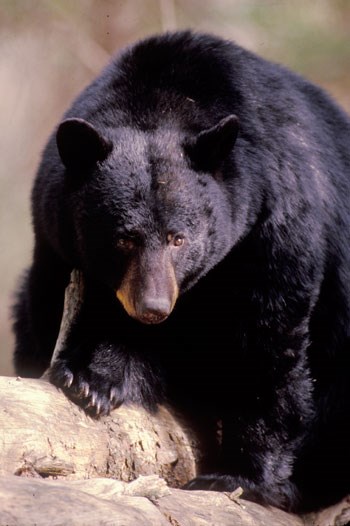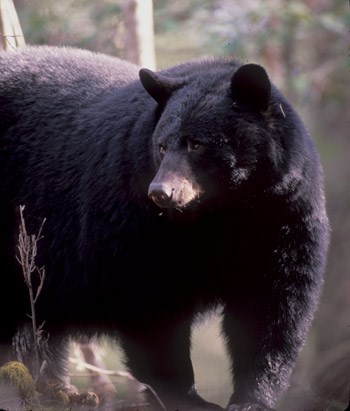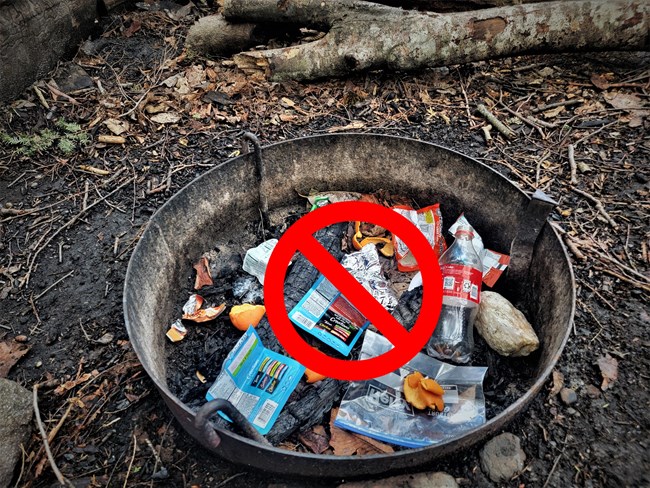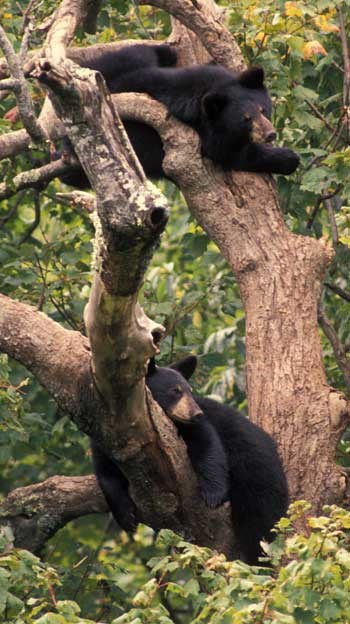Should I Be Afraid Of Animals While Camping
Warning: Bears are wild animals that are dangerous and unpredictable. Practice non approach bears or allow them to arroyo you lot!
Willfully approaching within 50 yards (150 feet), or any altitude that disturbs or displaces a carry, is illegal in the park. Violation of this federal regulation can result in fines and arrest. Apply binoculars, telephoto lens, or a spotting scope to view the animals.
Bank check the "Bear Closures" and "Bear Warnings" section of the Temporary Closures page before planning a hike in the park.

Gary Carter Photo
What Do I Do If I Encounter A Bear?
Bears in the park are wild and their behavior can be unpredictable. Although extremely rare, attacks on humans accept occurred, inflicting serious injuries and expiry. Treat carry encounters with farthermost caution! Learn what to do if you see a acquit by watching this short video.
If you run across a conduct:
- Remain watchful.
- Practice not approach it
- Do not allow the bear to approach yous.
- If the behave is at a altitude, feeding or walking by, and notices y'all just continues its natural behavior, no activity is needed on your part. Proceed while standing to observe the bear.
- If your presence causes the acquit to change its behavior (stops feeding, changes its travel direction, watches you, etc.) yous are too close.
- Existence likewise shut may promote aggressive behavior from the bear such as running toward you, making loud noises, or swatting the ground. The bear is enervating more space. Don't run, but slowly back abroad, watching the comport. Increment the distance between y'all and the behave. The comport will probably do the same.
If a carry persistently follows or approaches you, without vocalizing, or paw swatting:
- Alter your direction.
- If the bear continues to follow you, stand your ground.
- If the acquit gets closer, talk loudly or shout at it.
- Act aggressively to intimidate the behave.
- Act together as a group if you take companions. Make yourselves await as large as possible (for case, move to higher footing).
- Throw non-nutrient objects such as rocks at the bear.
- Use a deterrent such as a stout stick.
- If you are carrying bear spray, begin to discharge information technology when the deport comes inside 20 yards of you. Sentinel this video on how to safely use bear spray.
- Don't run and don't plough abroad from the bear.
- Don't leave food for the deport; this encourages further problems.
- Don't discharge a firearm; this can cause a safety hazardfor other visitors.
If the behave'due south behavior indicates that it is after your food and you are physically attacked:
- Split up yourself from the food.
- Slowly back away.
If the bear shows no involvement in your nutrient and you are physically attacked, the acquit may consider you as prey:
- Fight back aggressively with whatsoever bachelor object!
- Practice not play expressionless!

Gary Carter Photograph
Bears in the Smokies
Great Smoky Mountains National Park is one of the largest protected areas in the eastern Us where black bears can live in wild, natural surroundings.
Bears inhabit all elevations of the park. Though populations are variable, biologists judge that roughly 1,500 bears live in the park. This equals a population density of approximately 2 bears per square mile. At one time, the blackness conduct'southward range included about of North America except the extreme westward coast. Still loss of habitat has resulted in a significant reduction in this range.
Black bears in the Smokies are black in color, merely in other parts of the country they may be brownish or cinnamon. They may be six anxiety in length and up to iii anxiety high at the shoulder. During the summer months, a typical adult male bear weighs approximately 250 pounds while adult females are generally smaller and counterbalance slightly over 100 pounds. Notwithstanding, bears may double their weight by the fall. Bears over 600 pounds have been documented in the park. Bears tin live 12-15 years or more, however bears which have had access to man foods and garbage have a life expectancy of only one-half that time.
Bears, similar humans, are omnivores. Plant materials such as berries and nuts make up approximately 85% of their nutrition. Insects and animal carrion provide valuable sources of poly peptide for bears.
Bears have color vision and a keen sense of olfactory property. In addition, they are skillful tree climbers, tin swim very well, and can run thirty miles per hour.
Deport Behavior
Bears are most active during early morning and late evening hours in spring and summer. Mating usually takes place in July. Both female person and male bears may have more than than one mate during the summertime.
Bears choose a denning site with the coming of common cold weather. Dens are commonly hollow stumps, tree cavities, or wherever there is shelter. Bears in the Smokies are unusual in that they often den high above the footing in standing hollow trees. Bears exercise not truly hibernate, but enter long periods of sleep. They may leave the den for short periods if disturbed or during brief warming trends.
1 to 4 cubs are born during the mother'due south winter sleep, usually in tardily January or early February. Bears weigh eight ounces at birth. Females with newly built-in cubs ordinarily emerge from their wintertime dens in late March or early April. Normally born in pairs, the cubs volition remain with the mother for about 18 months or until she mates once again.

NPS Photo
Garbage and food scraps Kills Bears!
The bear's nifty sense of smell leads it to insects, nuts and berries, but the beast is likewise enticed by the tantalizing smells of human food and garbage such every bit hot dogs, apple tree cores, fries, and watermelon rinds left on the ground in picnic areas, campgrounds, and along trails. Feeding bears or allowing them admission to human food and garbage causes a number of problems:
- It changes the bear's behavior and causes them to lose their instinctive fearfulness of humans. Over time, these bears may begin approaching people in search of food and may get more unpredictable and dangerous.
- Bears that obtain homo food and garbage damage holding and hurt people. These bears pose a run a risk to public safety. They can also teach other bears this unsafe beliefs. Oftentimes, they must be euthanized.
- Studies accept shown that bears that lose their fearfulness of people by obtaining human food and garbage never alive equally long as bears that feed on natural foods and are shy and afraid of people. Many are striking by cars and become easy targets for poachers.
For these reasons, park rangers issue citations for littering, feeding bears, and for improper nutrient storage. These citations can upshot in fines of up to $5,000 and jail sentences lasting up to six months. Visitors are urged to view all wildlife at a safe distance and to never throw food or garbage on the ground or leave it unattended. Garbage Kills Bears!

Gary Carter Photo
Bear Management
Bear management is really people management. How visitors carry while in the park has an impact on the safe of bears. If you are devil-may-care with your food or litter, YOU may be responsible for a bear's decease!
The park has done many things to make it easier for you to protect bears. Bear proof dumpsters or trash cans tin can be found in all campgrounds and picnic areas. Please use them to dispose of garbage.
During summer months, some of the busiest picnic areas close at 8:00 PM so these areas can be thoroughly cleaned before dark and any food scraps or trash left by careless visitors tin can be removed. Park rangers patrol picnic areas and campgrounds to enforce evening closures, littering and food storage regulations. They as well strictly enforce regulations that prohibit approaching, harassing, disturbing or feeding bears.
An army of park volunteers patrol the park'southward well-nigh popular trails, picnic areas, and campgrounds to educate visitors about protecting bears. They confiscate unattended food or coolers and clean up food scraps left behind by devil-may-care visitors. These volunteers as well assist in managing people during roadside comport jams.
In the backcountry, food storage cables have been installed to make it easier for backpackers to hang their food and garbage and so that bears cannot get to it. At some campsites, phone poles were flown into remote backcountry areas because the trees around the campsites were too minor to gear up an effective cablevision system!
The park'due south Resource Education staff provides information about bears at company centers, in the park's newspaper, and at evening programs. Educational signs about bears can be institute on picnic tables throughout the park and behave rubber videos are posted on this website.
Wild fauna managers actively monitor for comport action and utilise innovative and proactive techniques to keep bears shy, secretive, and agape of people. This approach allows bears to remain in their home range, and discourages them from visiting adult areas or approaching people.
Results of these efforts are very encouraging. In some areas the number of bears that take to be trapped and moved away has decreased by x fold!
What Can You Practice To Protect Bears?
- Dispose of all garbage or food scraps in bear proof garbage containers or take it with you.
- Do non feed wildlife. Feeding a bear guarantees its demise!
- Do not approach inside 50 yards or whatsoever distance that disturbs a acquit.
- Exercise non allow bears to arroyo you (Come across "What Exercise I Do If I See A Carry?" above).
- Utilise the nutrient storage cables to shop your nutrient and garbage when camping ground in the backcountry.
- If you run across another visitor breaking these rules, or encounter a behave in a picnic expanse or campground, on a trail, or in any other developed area, please call (865) 436-1230 or stop at a Visitor Center to written report it.
Other Threats to Bears
Non-Native Species: The European wild hog is i of the most directly threats to the blackness bear. These pervasive intruders feed on the acorns and other foods that are mainstays of comport diets. Another non-native species, the gypsy moth, is expanding its range toward the park. This insect defoliates oak copse, weakening them and leaving them susceptible to other insects and diseases which may kill the trees. Not only could bear'due south nutrient source of acorns exist afflicted, simply some of the prime denning spots in old growth trees may be lost.
Poaching: Unfortunately, the lure of loftier profits on international markets encourages the poaching of black bears. Several cultures believe that acquit gall bladders, paws, and claws have medicinal powers or consider them gourmet delicacies.
Urban Encroachment: Customs and private developments near park boundaries are causing a loss in habitat for the bears. Poaching activities tin exist somewhat curtailed, and comport populations tin somewhen rebound from the losses. But once the critical habitats are destroyed, major declines in bear populations are inevitable. In improver, bears that venture exterior park boundaries into neighboring communities may encounter human food and go unpredictable, dangerous, and a threat to human safety.
Additional Information
Wild animals Watching in the Park
Every year park animals must exist destroyed because of mistakes humans make. Learn how to protect park wild fauna.
Acquire More About Black Deport Enquiry in the Park
Scientists at the University of Tennessee talk over work they conducted through 2009.
Appalachian Bear Rescue
This nonprofit organization is a rehabilitation, research, and education facility that cares for injured and orphaned bears.
Source: https://www.nps.gov/grsm/learn/nature/black-bears.htm
Posted by: florencesontoort.blogspot.com

0 Response to "Should I Be Afraid Of Animals While Camping"
Post a Comment